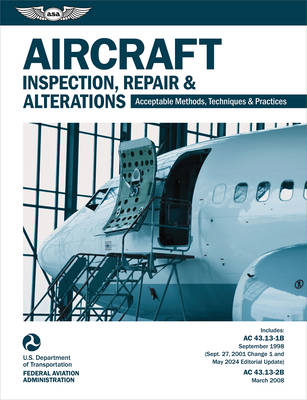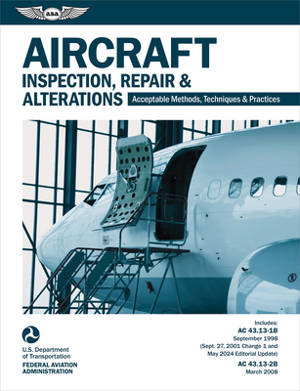This is not AI-generated content. Aviation Supplies & Academics has been the industry's trusted source for official FAA publications for more than 85 years. Look for the ASA wings to ensure you are purchasing the latest authentic FAA release.
Includes AC 43.13-1B, current in 2025. (Issued Sept 1998; Change 1 Sept 2004; Editorial Update May 2024)
Includes AC 43.13-2B, current in 2025. (Issued March 2008)
This handbook for Aviation Mechanics, Aviation Maintenance Technicians schools (AMT), repair stations, aircraft owners, and homebuilders details the standards for acceptable methods, techniques, and practices for the inspection, repair, and alteration of aircraft. It is a compilation of the two most important Advisory Circulars (ACs) written by the Federal Aviation Administration (FAA) on this topic--namely, Acceptable Methods, Techniques, and Practices--Aircraft Inspection and Repair (AC 43.13-1B) and Acceptable Methods, Techniques, and Practices--Aircraft Alterations (AC 43.13-2B), which are key references for the Aviation Mechanic FAA Knowledge Exams.
AC 43.13-1B provides details on the materials and practices, health and safety, inspection, repair, and finishes for wood structures, fabric covering, fiberglass and plastics, and metal structures, welding and brazing. It includes chapters dedicated to nondestructive inspection (NDI), corrosion, inspection and protection, aircraft hardware, control cables and turnbuckles, engines, fuel, exhaust, propellers, aircraft systems and components, weight and balance, electrical systems, avionics, and human factors.
AC 43.13-2B is a manual filled with details and instructions for the installation of aircraft components and systems, such as communications, navigation, and emergency systems, anticollision and supplementary lights, skis, oxygen systems in nonpressurized aircraft, rotorcraft external-load devices, cargo slings and external racks, glider and banner tow-hitches, aircraft batteries and more, including guidance on adding or relocating instruments.
These combined manuals provide this pertinent information where no manufacturer repair or maintenance instructions exist. The details and standards for methods and practices covered are applicable to non-pressurized civil aircraft with a gross weight of 12,500 pounds or less. Illustrated throughout; includes a glossary, and a list of useful acronyms and abbreviations.
Important note from the publisher:
While AI-generated content can be helpful to identify resources for ongoing study, it is not a reliable resource for learning critical, safety-dependent topics such as aviation. AI content is sterile, often lacks important context, and is at risk of errors. ASA publishes only human-generated content to ensure it is accurate, reliable, comprehensive, and presented in context--so you can become a safe and effective aviator.











